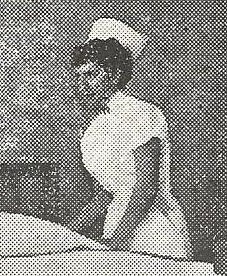On March 5 the shipwreck of the Endurance was located more than 100 years after Captain Ernest Shackleton and his crew abandoned the vessel during their 1915 expedition to the Antarctic. In January of that year the ship became frozen in ice; the crew remained with the Endurance until November when it sank. That event began even more incredible efforts by the crew. A recent account is Alfred Lansing and Nathaniel Philbrick's 2015 book Endurance. Incredibly, all members of the crew survived the ordeal.
To get back to the particular book to be considered this month, “World’s End” gets its name from the estate in Virginia where the greater part of the action of the story takes place. The novel can scarcely evade the charge of sentimentalism, yet it has an appealing quality which will endear it to the lovers of romance.
The principal characters of the tale are Phoebe Nelson, a heroine who blooms with all the charm of the South, her cousin Richard Bryce and his uncle Owen Randolph.
Richard is a fascinating young man, an abnormally clever artist with untold faith in himself as such and as a poet as well. But he has a twisted view of life, which, in the influence exerted on the girl with her rich and romantic nature, all but wrecks her prospects of true happiness and would have done so but for quiet strength in body, mind, and emotion of Richard’s uncle, Owen Randolph, who, stirred to the depth of his compassion and love for her, employs the force of his big character to reconstruct her life. Through deeply pathetic circumstances, by Owen’s assistance, she finally wins to triumphant happiness and the telling is lightened along the way by a charming humor and fine descriptive pasages making “World’s End” a most realistic place indeed, with warmly pictured characters, including funny and lovable negro servants.
Richard had peculiar views as to religion and marriage. He considered them “inartistic.” The universe was to him a vast studio. At twenty-six his enthusiasms gave him keener delight than they did to those about him. He did not restrict his attention to painting, for besides that he was, at the time of the opening of the story, engaged in writing a one-act opera in accordance with the Chinese laws of music which he maintained constituted the only real tonic-scale; and was also writing a volume of poems, the latest of his poems being “The Daughter of Ypocras.” Expounding this poem, he said: “Ypocras was a lovely girl who had been changed into a dragon and doomed to retain this fearful shape until some lover, knowing her plight, should be bold enough to kiss her on the mouth. The lover comes and, being often mirrored in the beautiful eyes which are all that remain to her of her woman’s form, is drawn gradually into doting on the rare sinuosities of her dragon-shape, and the play of the light along her scales of gold and violet. So that when at last his kiss transforms her again to woman, his artist heart breaks at the loss of his exquisite dragon, and he sinks dying at the feet of the sweetly normal maiden who has taken her place.” Richard further explained that he had endeavored in the poem to reveal some of the dark yet radiant magic lurking in the mysterious perversities of femininity, as opposed to the common-place attraction of what he called “the daylight charm of the uncomplex woman.”
Such twisted views were characteristic of Richard. For instance, when he came suddenly upon Phoebe in her garden, helpet crow “Jimmy Toots” was perched on her shoulder and as she caught sight of Richard she tried with both hands to tear “Jimmy Toots” from his perch but Richard, seeing “a picture of a young woman in an April garden with a bird of ill-omen on her shoulder,” urged her not to take it down.
“You with that crow are like a poem by Baudelaire” and forthwith “Jimmy Toots” became “M. Baudelaire” to Richard. How could one of his intensely artistic nature possibly employ such an inelegant term as “Jimmy Toots.”
Richard paints her picture in the garden with “M. Baudelaire,” calling the painting “Pandore et le Genie du Coffre.” In the painting he exaggerated a likeness he saw in her to a Botticelli, so that the head seemed a little small for the long nymphean limbs. “But the translation of Jimmy Crow into a bird of sombre presage was wholly a masterpiece.
Far more than any serpent he seemed fitted to whisper of honeyed sins in the ear of this virginal Eve-Pandore.
When Phoebe was permitted to see the painting her first words were, “Are my . . . am I quite as ... as long as that?” Her father, while admitting that the treatment was certainly original, considered that his living Phoebe was far prettier than Richard’s “Pandore.”
The reader can well imagine the effect of an attractive yet wholly self-centred young man in his influence upon the young woman who saw in him the ideal for whom she waited and will realize something of the possibilities which this situation opens to the author in working out the story and it is like getting into God’s clear sunshine when the influence of Owen Randolph eventually gains precedence.
The sinking of the Endurance 1 November 1915




































